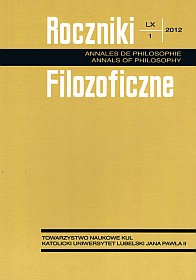The Manifest and Scientific Images of the World
Abstract
The article below consists of two parts. In the longer first one, we present the salient features of Sellars’ conception of the manifest and scientific images of the world, and seek to determine the ways in which these two elements may be said to be related to one another. On the basis of this, we then point out one of the sources of the contemporary mind-body problem. In the shorter second part, we outline a variety of philosophical and neuroscientific proposals for resolving the issue of the relationship between our everyday intuitive understanding of what the mental states of a person amount to and their brain states as described in strictly scientific terms.
References
Atmanspacher H.: Contextual Emergence from Physics do Cognitive Neuroscience, „Journal of Consciousness Studies” 14 (2007), No. 1-2, s. 18-36.
Babich B., Cohen R.S. (red.): Nietzsche, Epistemology and Philosophy of Science, Dordrecht: Kluwer 1999.
Bermúdez J.L.: Arguing for Eliminativism, [w:] B.L. Keeley (ed.), Paul Churchland, Cambridge: Cambridge Univ. Press 2006, s. 32-65.
Bremer J.: Rekategorisierung statt Reduktion. Zu Wilfrid Sellars’ Philosophie des Geistes, Göttingen: V&R.
Brook A.: Reconciling the Two Images, [w:] S. O’Nualláin (ed.), Two Sciences of Mind, Amsterdam: J. Benjamins, 1997, s. 299-310.
Campbell N.: A Brief Introduction to the Philosophy of Mind, Toronto: Broadview Press 2005.
Churchland P.: Problem umysłu i ciała, [w:] B. Chwedeńczuk (red.), Filozofia umysłu, Warszawa: Spacja, 1995.
Davidson D.: Zdarzenia mentalne, [w:] B. Stanosz (red.), Eseje o prawdzie, języku i umyśle, Warszawa: PWN 1992, s. 163-193.
Earley J.: How Philosophy of Mind Needs Philosophy of Chemistry, „Hyle” 14 (2008), s. 1-26.
Fodor J.: Eksperci od wiązów, Warszawa: Aletheia 2001.
Heaton J.M.: Wittgenstein and Psychoanalysis, Duxford: Icon 2000.
Hoyningen-Huene P.: Zu Emergenz, Mikro- und Makrodetermination, [w:] W. Lübbe (ed.), Kausalität und Zurechnung, Berlin: de Gruyter 1994, s. 165-195.
Koch Ch.: Neurobiologia na tropie świadomości, Warszawa: WUW 2004, s. 29-32.
Lycan W.G., Pappas G.S.: Quine’s Materialism, „Philosophia” 6 (1976), s. 101-130.
McDowell J.: Mind, Value, and Reality, Cambridge, MA: Harvard University Press 1998.
McGinn C.: Consciousness and Space, „Journal of Consciousness Studies” 2 (1995), s. 220-230.
Pearson K.A.: A Companion to Nietzsche, Oxford: Blackwell 2006.
Pérez D.I.: Is Thought without Language Possible?, „Principia” 9 (2005), s. 177-191.
Rosenberg J.: Fusing the Images, „Journal for General Philosophy of Science” 21 (1990), s. 1-23.
Sellars W.: Metaphysics and the Concept of a Person, [w:] tenże, Essays in Philosophy and its History, Dordrecht: D. Reidl Publ. Comp. 1974, s. 214-241.
Sellars W.: Empiricism and the Philosophy of Mind, [w:] tenże, Science, Perception and Reality, Atascadero: Ridgeview Publishing Company 1991, s. 127-196.
Sellars W.: Philosophy and the Scientific Image of Man (dalej: PSIM), [w:] tenże, Science, Perception and Reality, Atascadero: Ridgeview Publishing Company 1991 [1963], s. 1-40.
Sellars W.: The Carus Lectures, „The Monist” 1981, No. 64/1, s. 3-90.
Smart J.J.C.: Doznania a procesy mózgowe, [w:] B. Chwedeńczuk (red.), Filozofia umysłu, Warszawa: Spacja, 1995, s. 247-262.
Sperry R.: Mind, Brain, and Humanist Values, [w:] J.R. Platt (ed.), New View of the Nature of Man, Chicago: Chicago Univ. Press 1965, s. 71-92.
Sperry R.: Consciousness. Personal Identity and the Divided Brain, [w:] D.F. Benson (ed.), The Dual Brain. Hemispheric Spezialisation in Humans, New York 1985, s. 71-92.
Stephan A.: Emergenz, Dresden: Dresden Univ. Press 1999.
Weber M.: Wirtschaft und Gesellschaft. Grundriß der verstehenden Soziologie, Tübingen: Mohr 1990.
Copyright (c) 2012 Roczniki Filozoficzne

This work is licensed under a Creative Commons Attribution-NonCommercial-NoDerivatives 4.0 International License.





